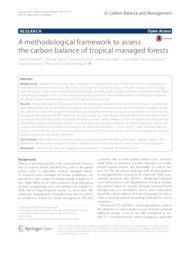A methodological framework to assess the carbon balance of tropical managed forests.
A methodological framework to assess the carbon balance of tropical managed forests.
Author(s): PIPONIOT, C.; CABON, A.; DESCROIX, L.; DOURDAIN, A.; MAZZEI, L.; OULIAC, B.; RUTISHAUSER, E.; SIST, P.; HÉRAULT, B.
Summary: Background: Managed forests are a major component of tropical landscapes. Production forests as designated by national forest services cover up to 400 million ha, i.e. half of the forested area in the humid tropics. Forest management thus plays a major role in the global carbon budget, but with a lack of unified method to estimate carbon fluxes from tropical managed forests. In this study we propose a new time- and spatially-explicit methodology to estimate the above-ground carbon budget of selective logging at regional scale. Results: The yearly balance of a logging unit, i.e. the elementary management unit of a forest estate, is modelled by aggregating three sub-models encompassing (i) emissions from extracted wood, (ii) emissions from logging damage and deforested areas and (iii) carbon storage from post-logging recovery. Models are parametrised and uncertainties are propagated through a MCMC algorithm. As a case study, we used 38 years of National Forest Inventories in French Guiana, northeastern Amazonia, to estimate the above-ground carbon balance (i.e. the net carbon exchange with the atmosphere) of selectively logged forests. Over this period, the net carbon balance of selective logging in the French Guianan Permanent Forest Estate is estimated to be comprised between 0.12 and 1.33 Tg C, with a median value of 0.64 Tg C. Uncertainties over the model could be diminished by improving the accuracy of both logging damage and large woody necromass decay submodels. Conclusions: We propose an innovating carbon accounting framework relying upon basic logging statistics. This flexible tool allows carbon budget of tropical managed forests to be estimated in a wide range of tropical regions
Publication year: 2016
Types of publication: Journal article
Unit: Embrapa Eastern Amazon
Observation
Some of Embrapa's publications are published as ePub files. To read them, use or download one of the following free software options to your computer or mobile device. Android: Google Play Books; IOS: iBooks; Windows and Linux: Calibre.
Access other publications
Access the Agricultural Research Database (BDPA) to consult Embrapa's full library collection and records.
Visit Embrapa Bookstore to purchase books and other publications sold by Embrapa.

